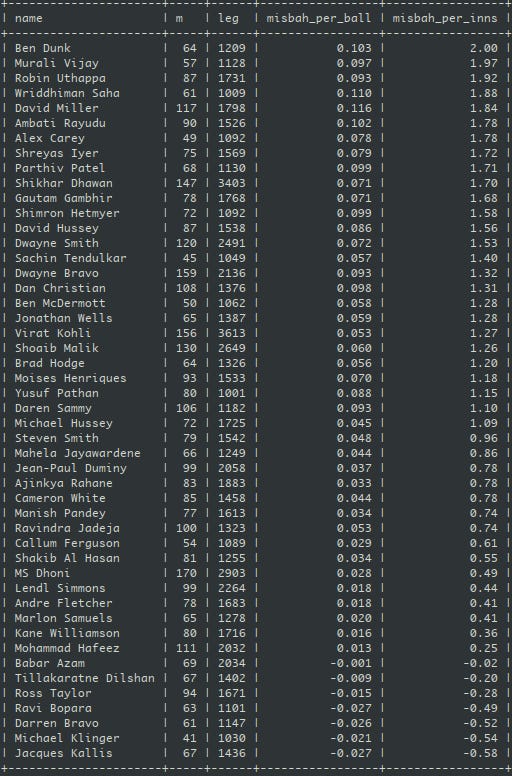This is not to say that you or I could replace India’s Test batting line up, or India’s T20 bowling line up.
Rather, it is to say that given the best 7-8 players available for these spots, it doesn’t matter which of these are picked because the batting lineup doesn’t affect who wins a Test match (the depth and quality of the bowling attack does), and the bowling lineup doesn’t affect who wins a T20 match (the depth of the hitting lineup does).
The expected runs from each ball in a T20 innings, depending on the two finite resources available to the batting side (balls remaining and wickets) are given here. This table gives the average runs scored from a delivery in T20 when a certain number of balls remain and a certain number of wickets have been lost. For example, when a 100 balls remain and one wicket has been lost (or, 9 wickets remain), 1.3 runs are scored from that ball. And so on.
This is calculated for the 1st innings of T20 - the setting innings when batting sides try to score as many as they can. Run chases are different, in that, there’s a required rate available at the start of each delivery in the chase.
Consider the 93 T20 bowlers who have bowled at least 1000 balls in the 1st innings of T20 matches in the top 5 leagues (IPL, BBL, CPL, PSL and The Hundred) and T20Is against Test playing opposition, combined. All 93 are listed in first two charts below (note that Shane Watson is repeated for continuity).
The “jogi” measure gives the difference between the runs conceded on a delivery and the expected runs. So, for example, with 100 balls remaining and 9 wickets in hand, 1.3 runs are expected to be conceded. The ball is hit for six, the jogi score is +4.7 (or, 4.7 runs more than expected). If the ball produces one run, the jogi score is -0.3 (or, 0.3 runs less than expected). For the bowler, achieving a negative jogi score is a win. For the batter achieving a positive score is a win. The score from the bowler’s point of view is called the “jogi”, while the score from the batter’s point of view is called “misbah” - a whimsical tribute to the last over of the 2007 World T20 final.
With this, we can estimate how a bowler does per match. The best bowler in this list of 93, is Sunil Narine. He concedes 5.45 runs less than average per match. The worst is Tom Curran who concedes 4.60 runs more than average per match. So, the difference between the best and worst bowler is 10 runs. This is the biggest possible difference between two bowlers.
Similarly, we can estimate the difference between the best and worst bat among those who have faced at least a 1000 balls in the 1st innings of games. There are 95 such batters, and their performance ranges from +6.1 runs (Glenn Maxwell) to -0.6 (Jacques Kallis). These are given in the batting tables below (Ben Dunk is repeated for continuity).
Basically, consider that Jasprit Bumrah concedes 3 runs less than the average expectation per match bowling in T20. There have been 29 batters in our T20 list who have contributed 3 runs more than the average expectation per match or better. There are only 3 bowlers who do better than Bumrah.
The upside for batters is significantly greater than the upside for bowlers.
Finally, I considered the 250 most experienced bowlers and batters in these T20 matches. 55 players appear in both lists. These are listed in the fifth and last chart in this article. The most telling figure in this chart is Sunil Narine’s batting figure - he contributes 2 runs better than average per match - better than all but six bowlers in the bowling list.
Batters take chances in T20. It is true that some bowlers are harder to hit than others. But given that bowlers get to bowl only 4 overs, the upside to picking better bowlers is trivial compared to the upside to picking better hitters. Glenn Maxwell is a superior net contributor than Rashid Khan.
Rashid Khan and Sunil Narine become significantly superior T20 players because they can hit.









I agree. T20 rules need to be changed to allow one or two bowlers to bowl more than their allotted quota of 4 overs. Same with ODIs. A good batsman on a day can bat for almost 50% of the innings, but a good bowler on a day cannot bowl more than 20% for the innings. This needs to change.
I'd love to see Bumrah, Rashid, Naraine bowl 36 balls in a T20 or 72 balls in an ODI. That'll make the game far more interesting and make bowlers more relevant.